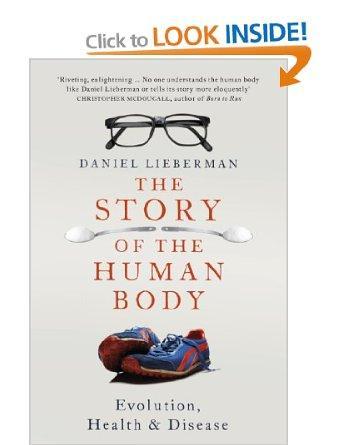 You may remember Daniel Lieberman from such books as “Born to Run”, a book that many a runner (including myself) put down and immediately vowed to eat only turnips and run barefoot. That book was responsible for the sale of millions of pairs of latex foot gloves at £100+ a go.
You may remember Daniel Lieberman from such books as “Born to Run”, a book that many a runner (including myself) put down and immediately vowed to eat only turnips and run barefoot. That book was responsible for the sale of millions of pairs of latex foot gloves at £100+ a go.
Leiberman is an evolutionary biologist which means his area of study is about “why” humans are the way they are. What events happen and what adaptions we made such that now, 4.5bn years on from when the Earth was formed (or about 6000 years depending on what books you read) why humans seem to fair well at survival.
Amazon.co.uk Widgets
Now it is silly to suggest that somehow humans are at the top of some sort of evolutionary order (if you measure success by the amount of biomass a species occupies on earth then ants win by some margin). However what is clear that over the past few million years where humans speciated from common ancestors share with chimps and other apes “we” have adapted to life on earth in a way that is fairly unique. We live longer, have low infant mortality, spend relatively small amounts of the day ensuring we have enough calories and are unique in the animal kingdom in having offspring that are completely helpless until the age of about 18 years.
The main drive of the book is that while there were an number of things that we evolved to adapt to certain climate and food situations (such as bipedalism, larger brains, longer child weaning times, hands and so forth) that the change in our situations over the past 13000 has developed far faster than our bodies can adapt. We adapted to the dwindling forests over millions of years by walking out on the plains. We adapted to warming and cooling by very gradually growing hair and losing hair.
However there have been two changes over the past 13000 years that have changed human lives too fast for our genes to “keep up”. The first is the agricultural revolution of around 13k years ago and the second was the industrial revolution around 200 years ago.
Humans as well as all life on earth usually have to play a balancing act between getting enough calories out of the earth and then investing effort into reproduction. You can’t spend all time eating and then reproduce but then you can not reproduce and pay the heavy costs of child rearing without energy. This is a trade off that generally keeps animals on the edge of existence, keeps their bodies lean and mean and specialized in whatever environment they are currently in and to deal with whatever predators and prey are around.
Human hunter gatherers were estimated to run/walk around 15k per day in pursuit of this energy that allowed them to invest in reproduction however the invention of farming changed the foods we ate and reduced the energy issue. Farming was still an intense physical activity and so we still burned a lot but the insecurity around food was reduced massively as we started to eat more grains and roots.
Up until 200 years ago to survive you still had to work pretty hard. That changed during the industrial revolution where labor intensive tasks were replaced by machines and now in 2013 we end up doing most of our work at a computer, burning very few calories at all.
So here we are, a product of evolution that survived ice ages and deforestation but now has too much food and does too little work. The result of these are what Lieberman describes as “mismatch diseases”, not typical infectious diseases that we risk in nature but ones that are common now due to us spending so much more time sitting around and having an adundance of food. He argues that many diseases are not inevitable sign of aging (hunter gatherers lived long lives too) but the way we live now.
Cancers, diabetes, heart problems and mental health problems can all be explained to some extent by the massively different life we live now vs 200 years ago and 13000 years ago.
It is not a suggestion that we should all go back to the stone age and eat worms, lick rocks and wear vibrams but it is a great account of just what our bodies were designed for and what we are using (or misusing) them for nowadays.
There are a number of other books I would recommend that give an interesting account of the human body. Waterlogged as well as being an epic rant at the sports drink industry contains a lot of good stuff. I would also recommend reading "Anti-fragile" - not at all focused on running or the body but it gave me a different way of thinking about medicine and food.
But part of me kind of hopes for an apocalypse situation where maybe the seas rise or the forests dwindle. At that point only those who can adapt the best will be able to survive. I doubt those are the same people watching Dance Factor or getting on an elevator and pressing 1.
